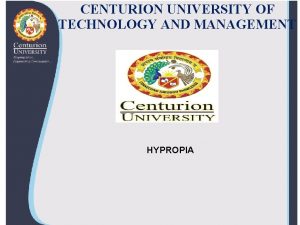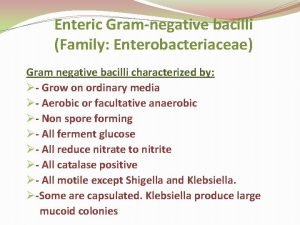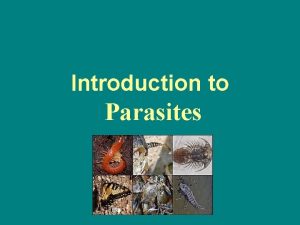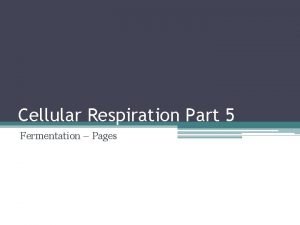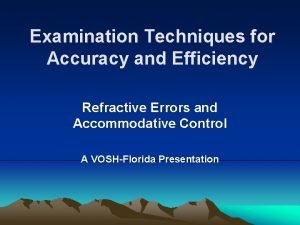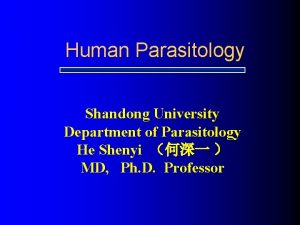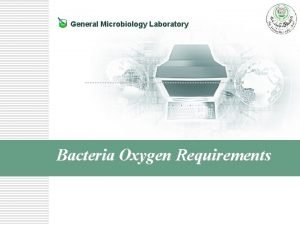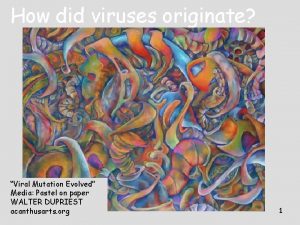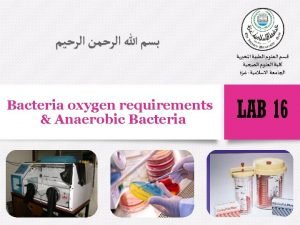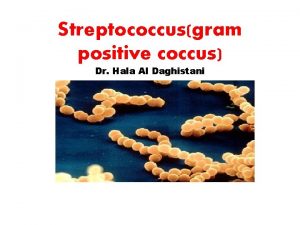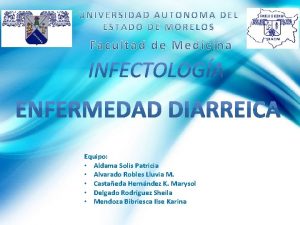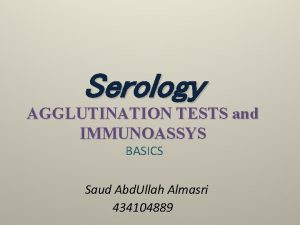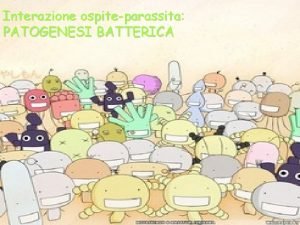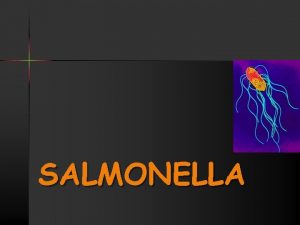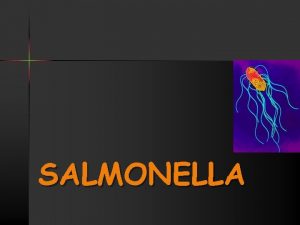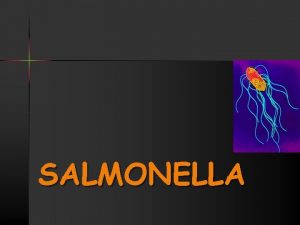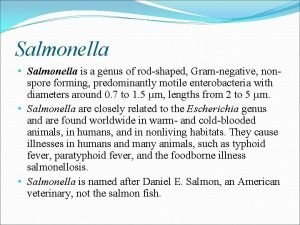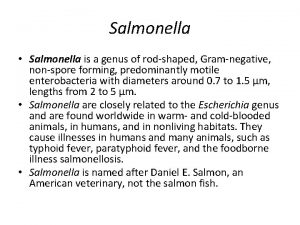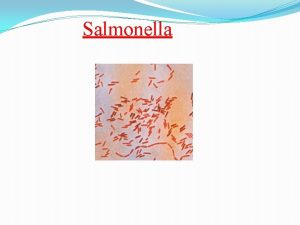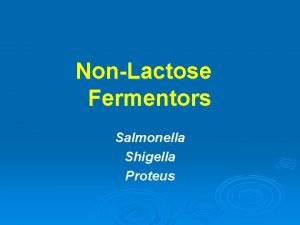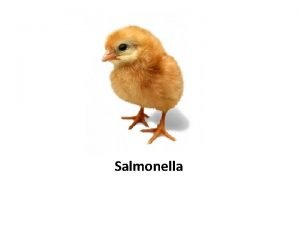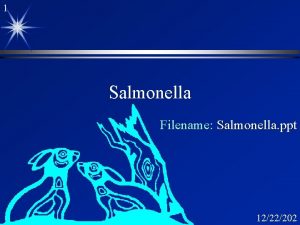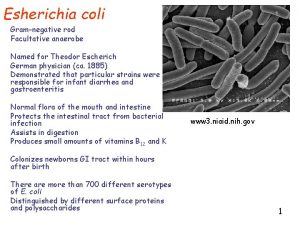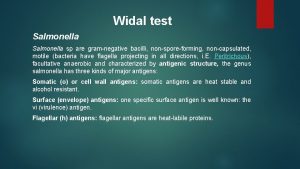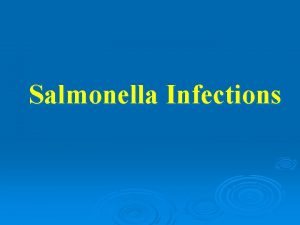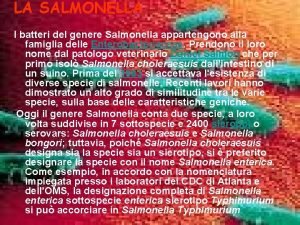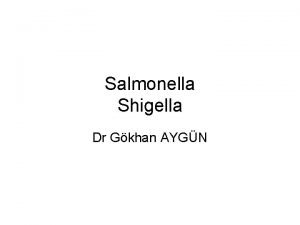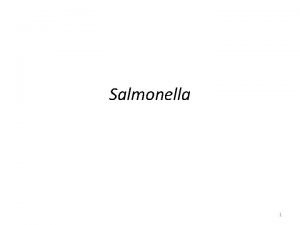SALMONELLA n Salmonella is a Gramnegative facultative rodshaped




















- Slides: 20

SALMONELLA

n Salmonella is a Gram-negative facultative rodshaped bacterium belonging to family Enterobacteriaceae, n Salmonellae live in the intestinal tracts of warm and n In humans, Salmonella are the cause of two diseases called salmonellosis: cold blooded animals. Some species are ubiquitous. Other species are specifically adapted to a particular host. – enteric fever (typhoid), resulting from bacterial invasion of the bloodstream, and – acute gastroenteritis, resulting from a foodborne infection/intoxication.


Morphology Gram – negative rods n uncapsulated (except S. typhi) n unsporulatedsporulaţi n Peritrichous flagella (ensure motility) n


Cultural properties n n Aerobe-anaerobe facultative Grow easily on simple culture media Onto selective and differential media that contain biliary salts and lactose grow like lactose-negative “S” colonies. produce de H 2 S, colonies have a “cateye” appearance.








Biochemical properties n n n n Motile, Lactose negative; acid and gas from glucose, mannitol, maltose, and sorbitol; no Acid from adonitol, sucrose, salicin, lactose ONPG test negative (lactose negative) Indole test negative Methyl red test positive Voges-Proskauer test negative Citrate positive (growth on Simmon's citrate agar) Lysine decarboxylase positive Urease negative Ornithine decarboxylase positive 2 S produced from thiosulfate Phenylalanine and tryptophan deaminase negative Gelatin hydrolysis negative

TSI (Triple Sugar Iron) MIU (Motility Indole Urea). Simmons Citrate medium




Diagnosis n n n The diagnosis of salmonellosis requires bacteriologic isolation of the organisms from appropriate clinical specimens. Laboratory identification of the genus Salmonella is done by biochemical tests; the serologic type is confirmed by serologic testing. Feces, blood, or other specimens should be plated on several nonselective and selective agar media (blood, Mac. Conkey, eosin-methylene blue, bismuth sulfite, Salmonella-Shigella, Hektoen agars) as well as intoenrichment broth such as selenite or tetrathionate.

n n The biochemical reactions of suspicious colonies are then determined on triple sugar iron agar and lysine-iron agar, and a presumptive identification is made. Biochemical identification of salmonellae has been simplified by systems that permit the rapid testing of 10 -20 different biochemical parameters simultaneously. The presumptive biochemical identification of Salmonella then can be confirmed by antigenic analysis of O and H antigens using polyvalent and specific antisera. Salmonella isolates then should be sent to a central or reference laboratory for more comprehensive serologic testing and confirmation.
 Hyermetropia
Hyermetropia Is carbon a macronutrient
Is carbon a macronutrient Facultative reinsurance
Facultative reinsurance Facultative gram negative bacilli
Facultative gram negative bacilli Facultative parasite
Facultative parasite Obligate vs facultative
Obligate vs facultative Latent hyperopia
Latent hyperopia Insurance and reinsurance
Insurance and reinsurance Facultative hibernation
Facultative hibernation Parasitism
Parasitism Facultative anaerobe
Facultative anaerobe Enseigner deutsch
Enseigner deutsch Oxygen requirements
Oxygen requirements Dyesthesiasis
Dyesthesiasis Obligate facultative
Obligate facultative Facultative anaerobe
Facultative anaerobe Treaty reinsurance
Treaty reinsurance Que tipo de celula es la salmonella
Que tipo de celula es la salmonella Salmonella antibody
Salmonella antibody Salmonella life cycle
Salmonella life cycle Isole di patogenicità salmonella
Isole di patogenicità salmonella
